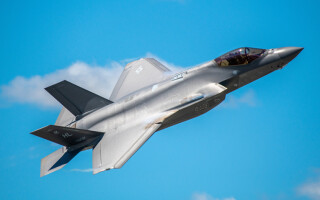Sustainment: A critical component of military avionics development
StoryMay 11, 2023

The defense industry relies on durable, dependable RF [radio frequency] systems for mission-critical military avionics applications, such as electronic warfare (EW), to enable continuous real-time data transmission with high accuracy. These systems must be extremely reliable and offer consistently high performance for many years in demanding, confined, and variable environments within the airframe. This creates unique requirements for the custom RF interconnect solutions that support them.
Development is only the first step in the operational life of a military avionics system. It can take as much as five years or more to build, test, and field a new electronic warfare (EW) system. After the initial development and deployment, the attention shifts to sustainment for the next 20, 30, and even 40 years. In fact, most life cycle costs in a U.S. military program are spent on sustainment and operations – an average of 70 cents per dollar – according to a report from the U.S. Department of Defense (DoD).
Cable assemblies should be a highly reliable part of the airframe infrastructure. They are among the first things to be installed into the bare airframe before the hydraulics, actuators, equipment racks, walls, flooring, seats, etc.; replacing a failed cable assembly is extremely difficult. Therefore, once installed, they should be rugged enough to last the life of the platform. The ability to design products on this basis results from decades of accumulated experience in supporting many airborne programs.
It is also essential to consider sustainment early on in a program’s development to maximize the availability of components over their life cycles. This concept, known as designing for sustainment, includes developing requirements built into the design of a material solution to deliver long-term operational availability. For example, the B-52 aircraft developed in the 1960s, ALR-69 radar warning receivers from the 1970s, and ALQ-131 jamming pods created in the 1980s all still provide significant operational utility due to smart sustainment strategies. However, budget pressures, competing priorities, time, and other factors present constant sustainment issues. (Figure 1.)

[Figure 1 | The AN/ALQ-131 electronic countermeasures (ECM) pod (shown here in a Northrop Grumman photo) – a modular, canister-contained, airborne ECM jamming pod that targets anti-aircraft radars – has been used by the U.S. and other countries’ militaries since the 1980s.]
Additionally, there is a continual need to balance new system development with refurbishing or manufacturing legacy components, creating a more significant sustainment challenge. Finally, part obsolescence issues present further challenges as many companies that initially manufactured those parts eventually stop making them.
Looking at the long term
To alleviate these challenges and ensure military avionics systems are designed for sustainment, suppliers must work with experienced, agile component manufacturers with a proven track record and long heritage of developing these solutions. This will help ensure continued operational excellence and mitigate the risk of supply-chain disruptions.
First, a strong industry history is essential because military avionics systems are incredibly complex to build and must last for decades. Therefore, working with a reliable partner with products that will stand the test of time is crucial. With this type of life-and-death application, it is not the time to be a test subject or proving ground for a newcomer to the space. Manufacturers must also understand the essential elements: Partners with a long heritage in avionics will thoroughly understand the importance of things like lightweight cables. They must also understand the ramifications of such an option, knowing the appropriate trade-offs to create high-performance, reliable products that last while keeping weight reduction top of mind. (Figure 2.)

[Figure 2 | An example of a lightweight cable: The MaxGain 300 cable assemblies from Times Microwave Systems are designed to provide high-performance and ultra-low-loss microwave coaxial cables. These assemblies use a unique spiral outer conductor technology, making them lightweight and reliable for high-frequency avionics interconnect.]
More than the standard solution
Suppliers often provide a standard product that may appear to meet key requirements but may not be the optimal choice, particularly when designing for sustainment. A long-term partner will have an engineering team that understands the challenges of the program’s unique application and be able to develop a custom solution to address those specific needs. If the partner is truly experienced, they have solved similar challenges many times and can readily address the situation at hand.
Moreover, service and support are paramount. A partner designing its products with sustainment in mind offers solutions such as replaceable parts and connectors, ensuring convenient maintenance and repair. In the unfortunate event that something is damaged or fails, the design ideally has been designed with field-repairable options, so the entire airframe is not required to be disassembled for repair. Lastly, and very importantly is the supply chain: If a replacement or spares are needed, the program should be able to obtain them quickly and easily.
The bottom line: Military avionics systems must be reliable for decades, and the components that go into those products must stand the test of time. Therefore, working with an experienced partner with a proven track record, a deep understanding of system design, and the ability to provide exemplary service and support for sustainment is crucial to ensure continued operational excellence and mitigate the risk of supply-chain disruptions.
Sustainment is a crucial factor for avionics systems. Components must be maintained or re-engineered throughout the life of the system. Choosing a partner capable of manufacturing and maintaining trusted, durable, and reliable components will extend the program’s life.
David Slack is director of engineering at Times Microwave Systems. He has extensive experience in the development of high-performance coaxial cable interconnects and related technologies. He received a bachelor of science degree in electrical engineering from Fairfield University.
Times Microwave Systems https://timesmicrowave.com/







